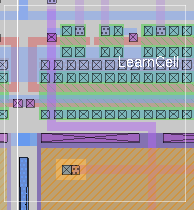



Command-line invocation (usage)
Script Invocation
Magic command summary
Screenshot of MagicThis screenshot, from Magic version 7.2, shows off a number of features of the Tcl version, including the cell manager window, the tech manager window, the toolbar, the console command-line entry window, and popup dialog boxes. Also shows off the version 7.1+ features of the OpenGL display and the non-Manhattan geometry extension.
Basic usage:
magic [-noc[onsole]] [-now[rapper]] [-d devType] [-T technology] [file]
where:Other standard usage:
- -noconsole
- (Tcl version only) Uses the calling terminal for terminal-based command-line input. Otherwise, a Tk console window is used.
- -nowrapper
- (Tcl version only) Magic layout windows use the GUI wrapper, including cell and technology manager windows, layer toolbar, and file menu.
- -d devType
- (all versions) Select the graphics interface at runtime. Specifying an invalid devType will result in a list of known types. The possible values of devType are determined at compile time, but the usual ones are NULL (no graphics), X11, and OpenGL. X11 is the usual default.
- -T technology
- (all versions) Select the appropriate technology (.tech) file. At present (this is on the to-do list), magic cannot change technology after startup. So the technology file corresponding to the layout to be loaded must be supplied to the command line at startup. The default technology is scmos, which is included with the magic source distribution. The complete list of available technology files depends on what has been installed on the system (see the technology file page for details).
- file
- (all versions) Load the layout (.mag) file file into the layout window on startup.
magic [-dnull] [file]
magic [-r[ecover]]
where options are as follows:-recoverComplete usage information:
This option recovers a layout after a crash. Note that crash recovery files are only automatically created and updated by the Tcl/Tk version of magic. A single file containing multiple layouts is placed in the /tmp directory. Upon normal program exit, it is removed. However, if magic terminates abnormally due to a program bug, reception of a termination signal from the operating system, or a system crash or shutdown, the file will remain and can be recovered. It is very important that you recover the file from the same directory where it was initially created; otherwise, if startup conditions are different (such as a different technology specified), layout may be lost.-dnull file
This option starts magic without graphics. It is appropriate for running magic in batch mode from a script. Note that there is a subtle difference between options "-d null" and "-dnull". The former starts magic without the ability to create a layout window, but still invokes the graphics initialization routines (in the Tcl/Tk version, a Tk window may briefly appear). The latter form specifically ignores all graphics and therefore runs with less overhead on startup.
magic [-noc[onsole]] [-now[rapper]] [-nowindow] [-d devType] [-T technology] [-m monType] [-D] [file]
where the additional options not covered above are:
-nowindowObsolete usage information:
(Tcl version only) Run without displaying an initial layout window. This is used mainly for GUI wrapper scripts which like to generate and handle their own windows.-m monType
(obscure) monType names a monitor type. This is used in the search for the colomap file name, which is designated <tech>.<planes>.<mon>.cmap1. The default is "std" (corresponding to colormap file "mos.7bit.std.cmap1". The only other monitor type for which colormaps exist in the distribution is "mraster". This provides a way for users to override the system color assignments.-D
(all versions) Run in Debug mode.
magic [-g gPort] [-i tabletPort] [-F objFile saveFile] ...
where the additional options not covered above are:
-g gPort
(largely obsolete) gPort names a device to use for the display. This was generally used in the past with dual-monitor systems, especially Sun systems in which the layout display might go to /dev/fb.-i tabletPort
(largely obsolete) tabletPort names a device to use for graphics input. This has not been tested with modern graphics tablet devices. It is ignored by the X11 and OpenGL display interfaces.-F objFile saveFile
(largely obsolete) Create an executable file of the current magic process, a core image snapshot taken after all initialization. objFile is the name of the original executable, and the image will be saved in saveFile. This only works on VAXen and SUNs running an old SunOS (using a.out executables).
Often it is helpful to have a shell script invoke magic with specific options to perform tasks such as generating a GDS file for tapeout. The following example code clip imports GDS into magic as a "vendor cell":
magic -dnull -noconsole << EOF drc off box 0 0 0 0 load vtop.mag -force drc off gds readonly true gds rescale false gds read ${cellname}.gds cellname rename ${cellname} vtmp load vtmp select top cell set pname [lindex [cellname list children] 0] cellname rename \\\$pname ${cellname} select cell \\\${pname}_0 identify ${cellname}_0 writeall force ${cellname} quit -noprompt EOF
add cleanup cull dnet dterm extract find flush join netlist orient pushbutton ripup savenetlist shownet showterms trace verify writeall
cif closewindow cutbox defaults help level refresh render scroll see view zoom
pushbutton color load save
*bypass *coord *extract *plow *psearch *showtech *tilestats *tsearch *watch
*crash *files *grstats *pause *winddebug *winddump
To be done:
- Add some general topics, not command-specific.
- Incorporate a lot of the currently text-only material into HTML format.
- Run latex2html on all of the LaTeX distribution documentation.
- More information on the routers and netlists
- Subject index.

| email: | 
|
Last updated: April 11, 2021 at 11:07am